ICSE Board Question Paper Class – X (2008)
SCIENCE
Paper 1 (Physics)
(One hour and a half)
General Instructions:
1. Answers to this Paper must be written on the paper provided separately.
2. You will not be allowed to write during the first 15 minutes.
3. This time is to be spent in reading the Question Paper.
4. This time given at the head of this paper is the time allowed for writing the answers.
5. Section - I is compulsory. Attempt any four questions from Section II
6. This intended marks for questions or parts of questions are given in brackets [].
SECTION – I (40 Marks)
Attempt all questions from this Section
Q1.
(a) Name the SI unit of 2
(i) Linear momentum
(ii) Rate of change momentum.
(b) A body of mass 1.50 kg is dropped from the 2nd floor of a building which is at a height of 12 m. What is the force acting on it during its fall? (g=9.80 m/s2). 2
(c) When an arrow is shot from a bow, it has kinetic energy in it. Explain briefly from where does it get its kinetic energy? 2
(d) What energy conversions take place in the following when they are working- (i) Electric toaster (ii) Microphone? 2
(e) Copy the diagram of the forearm given below, indicate positions of Load, Effort and Fulcrum.
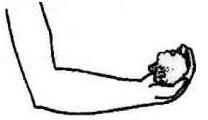
Q 2.
(a) (i) A monochromatic beam of light of wavelength X passes from air into a glass block. Write an expression to show the relation between the speed of light in air and the speed of light in glass.
(ii) As the ray of light passes from air to glass, state how the wavelength of light changes. Does it increase, decrease or remain constant? 2
(b) In what way will the temperature of water at the bottom of a waterfall be different from the temperature at the top? Give a reason for your answer. 2
(c) A radar sends a signal to an aero plane at a distance 45 km away with a speed 3 x 10g ms-1. After how long is the signal received back from the aero plane? 2
(d) Draw a ray diagram to illustrate the determination of the focal length of a convex lens using an auxiliary plane mirror. 2
(e) What is meant by primary colors? Name the primary colors of light. 2
(a) (i) Sketch a graph to show the change in potential difference across the ends of an ohmic resistor and the current flowing in it. Label the axes of your graph.
(ii) What does the slope of the graph represent? 2
(b) Draw a labeled diagram of the staircase wiring for a dual control switch showing a bulb in the circuit. 2
(c) The electrical gadgets used in a house such as bulbs, fans, heater, etc, are always connected in parallel, NOT in series. Give two reasons for connecting them in parallel. 2
(d) An electrical heater is rated 4 kW, 220V. Find the cost of using this heater for 12 hours if one kWh of electrical energy costs Rs. 3.25. 2
(e) State one point of similarity and one point of difference between an a.c. generator and a d.c. motor. 2
Q 4.
Two isosceles right-angled glass prisms are placed near each other as shown in the figure.
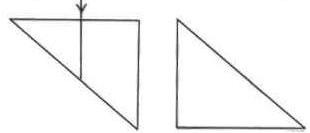
(a) Complete the path of the light ray entering the first isosceles right angled glass prism till it emerges from the second identical prism. 2
(b) A certain quantity of ice at 0 degree C is heated till it changes into steam at 100 degree C. Draw a time-temperature heating curve to represent it. Label the two phase change in your graph. 2
(c) What is meant by work function of a metal? 2
(d) What is radioactivity? 2
(e) Mention any two differences between nuclear energy and chemical energy. 2
SECTION II (40 Marks)
Attempt any four questions from this Section
Q5.
(a) (i) A stone of mass 64.0 g is thrown vertically upward from the ground with an initial speed 20.0 mis. The gravitational potential energy at the ground level is considered be zero. Apply the principle of conservation energy and calculate the potential energy at the maximum height attained by the stone. (g = 10 m s-2 )
(ii) Using the same principle, state what will be the total energy of the body at its half-way point? 3
(b) Define ‘joule’, the SI unit of work and establish relationship between the SI and CGS unit of work. 3
(c) (i) Draw a labeled diagram of a block and tackle system of pulleys with two pulleys in each block. Indicate the directions of the load, and effort and tension in the string.
(ii) Write down the relation between load and the effort of the pulley system. 4
Q 6.
(a) What is meant by the ‘aperture’ and ‘shutter speed’ of a camera? How are they related? 3
(b) (i) Draw a labeled ray diagram to illustrate (1) critical angle (2) total internal reflection, for a ray of light moving from one medium to another.
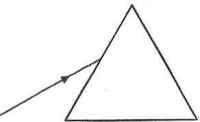
(ii) Write a formula to express relationship between refractive index of the denser medium with respect to rarer medium and its critical angle for that pair of media. 3
(c) (i) The diagram below shows a ray of light incident on an equilateral glass prism placed in minimum deviation position. Copy the diagram and complete it to show the path of the refracted ray and the emergent ray.
(ii) How are angle of incidence and angle of emergence related to each other in this position of the prism? 4
Q 7.
(a) (i) What is meant by an echo? Mention one important condition that is necessary for an echo to be heard distinctly.
(ii) Mention one important use of echo. 3
(b) (i) What is the name given to a cylindrical coil whose diameter is less in comparison to its length?
(ii) If a piece of soft iron is placed inside the current carrying coil, what is the name given to the device?
(iii) Give one use of the device named by you in (b) (ii) above. 3
(c) (i) Sometimes when a vehicle is driven at a particular speed, a rattling sound is heard. Explain briefly, why this happens and give the name of the phenomenon taking place.
(ii) Suggest one way by which the rattling sound could be stopped. 4
Q 8.
(a) (i) Why does a magnetic needle show a deflection when brought close to a current carrying conductor?
(ii) A wire bent into a circle carries current in an anticlockwise direction. What polarity does this face of the coil exhibit? 3
(b) Three resistors 6.0 Q, 2.0 S2, and 4.0 S2 respectively joined together as shown in the figure. The resistors are connected an ammeter and to a cell of e.m f. 6.0 V.
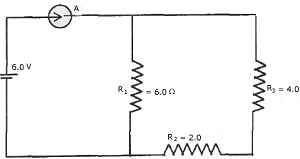
Calculate:
(i) the effective resistance the circuit.
(ii) the current drawn from the cell. 3
(c) (i) How does the heat produced in a wire or a conductor depend upon the:
(1) current passing through the conductor.
(2) resistance of the conductor?
(ii) Draw a simple sketch of a step down transformer. Label the different parts in the diagram. 4
Q 9.
(a) (i) Define heat capacity of a given body. What is its SI unit?
(ii) What is the relation between heat capacity and specific heat capacity of a substance? 3
(b) A linear object is placed on the axis of a lens. An image is formed by refraction in the lens. For all positions of the object on the axis of the lens, the positions of the image are always between the lens and the object.
(i) Name the lens.
(ii) Draw a ray diagram to show the formation of the image of an object placed in front of the lens at any position of your choice except infinity. 3
(c) A piece of ice of mass 40 g is dropped into 200 g of water at 50 °C. Calculate the final temperature of water after all the ice has melted. (specific heat capacity of water = 4200 J/kg °C, specific latent heat of fusion of ice = 336 x 103JU 4
Q 10.
(a) (i)When does the nucleus of an atom become radioactive?
(ii) How is the radioactivity of an element affected when it undergoes a chemical change to form a chemical compound?
(iii) Name the product of nuclear fission which is utilized to bring about further fission of 23592U. 3
(b) (i) Mention one use and one harmful effect of radioactivity.
(ii) Give one source of background radiation. 3
(c) (i)
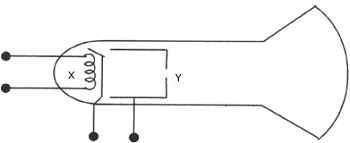
The above diagram shows an electron gun of a hot cathode ray tube,
1. Name the parts X and Y.
2. A6 V d.c. source and a 1000 V d.c. source are available. Show how these source be connected to the terminals of X and Y so to obtain a focused beans of fast moving electrons.
(ii) Give one use of a cathode ray tube. 4